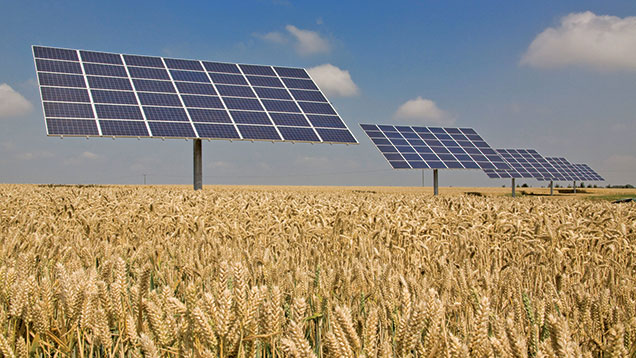Smaller solar farm sites gaining popularity
 © Tim Scrivener
© Tim Scrivener Interest in small- and medium-scale solar is growing, both for farmer-owned sites and lease projects.
With the recent focus on getting some of the much larger (5MW-plus) projects up and running before a change in the way these are supported takes effect, developers have often overlooked opportunities for 1-2MW sites, says Giles Hanglin, director at Savills Energy .
See also: Consider tax before signing land to solar leases
These require about five to 10 acres, can be more attractive for farmers and easier to achieve than larger schemes.
They also offer more certainty in inheritance tax (IHT) planning as they are far less likely to jeopardise the ability to claim Agricultural Property Relief on the remainder of the farm or estate.
Some landowners are taking the development risk on these sites, selling them on after having achieved planning consents and grid connections.
Ground-mounted solar projects which are installed and owned outright by landowners are more likely to be in the region of 50-250kWp, taking up a land footprint of one or two acres, says Mr Hanglin.
Returns on such projects can be in the region of 10-12% over 25 years, including capital being repaid between seven and 10 years into the project, he says.
Solar site essentials
Apart from grid connection, there are several pre-requisites for solar sites:
- Must be free of flood risk – an issue both for planners and investors
- No public footpaths through or near sites
- Not overlooked by residential or historic buildings such as churches
- Not in green belt
- Must be Grade 3b or poorer quality land
This is from a total capital investment cost of between £50,000 and £250,000, depending on installation size (up to 250 kWp) and including grid connection costs.
“These installations may not meet all the electricity needs of a working farm, but they can significantly contribute – powering a cold store or poultry shed, for example.
“Rooftop solar continues to grow too, with the government keen to encourage this type of development which offers returns in the region of 10-15% for property owners and tenants.”
Managed correctly, renewable energy can help reduce business risk, not only from an income perspective but from an energy security angle too, says Mr Hanglin. All properties with solar-mounted outlets are legally required to have an energy performance assessment.
“The biggest challenge for many projects remains grid connection, often delaying a project and while FiTs rates can be booked, installations still have to complete within a six month period in order to get the better rate.”
There are limited opportunities to bypass the grid connection issue by selling surplus power generated to a neighbour, although the copper wire required for the transmission is very expensive and once more than 50m is required, loss of power through those wires can be an issue, says Mr Hanglin.
While there are many developers out there looking to lease land for solar, the highest rental sum offered may not provide the best return in the long term, he warns.
He suggests key questions to ask an installer before signing a deal include:
- How long has the company been operating – in general, the longer the better
- What’s their track record?
- How much experience do they have in the farming sector?
- What do others in the industry say about the installer?
- Is their balance sheet strong?
- What is the warranty period and will the company be around for the whole of it?
- Do they offer competitive prices and warranties with good “Tier 1” (best quality) equipment?
- What’s included in the quote and what is an option extra, at what cost? Optional extras should be clearly marked and are likely to be items such as fencing, cameras and other security equipment, concrete plinths for housing equipment such as inverters.
Upcoming energy developments
The Department of Energy and Climate Change (Decc) has consulted on reducing planning constraints on rooftop projects and introducing transferability for subsidies if a rooftop solar installation is moved from one building to another. While this has not been finalised, it is likely it will go ahead.
All properties will have to meet an Energy Performance Certificate rating of E or above from 1 April 2018. Without this, buildings cannot be sold or rented.
